Discrepancies of Measured SAR between Traditional and Fast Measuring Systems
Abstract
:1. Introduction
- Why do discrepancies appear for the estimation of SAR by different fast measuring systems?
- Can we say fast measuring systems generate biased estimations if they differ appreciably from the traditional SAR measuring system?
- Which of the traditional measuring system and the fast measuring system is the more accurate?
2. Traditional SAR Measuring System
- Area scan: measure fields according to a two-dimensional coarse grid, the distance of which to the phantom surface is fixed, to locate the local maxima of the amplitude of electric fields.
- Zoom scan: a three-dimensional scanning within cubes centered at the location of local maxima, the grid step being smaller than that in the area scan.
- Interpolation and extrapolation: linear interpolation and cubic spline interpolation (and extrapolation) are used as necessary to deduce the amplitude at the points in a finer grid.
- Peak spatial-average SAR: obtained by performing numerically the integration in (1) based on the interpolated and extrapolated amplitude.
3. Fast SAR Measuring System Based on Field Reconstruction
3.1. Plane-Wave Expansion (PWE)
3.2. Field Reconstruction Making Use of More High-Frequency Components
4. Numerical Results
4.1. Configurations
4.2. Verification of Post-Processing Procedures
4.3. Problem in Field Reconstructions
4.4. Uncertainty of Factors
4.5. Comparison between the Traditional and Fast Measuring Systems
5. Conclusions
Author Contributions
Funding
Acknowledgments
Conflicts of Interest
References
- Kshetrimayum, R.S. Mobile phones: bad for your health? IEEE Potentials 2008, 27, 18–20. [Google Scholar] [CrossRef]
- Van Deventer, E.; Van Rongen, E.; Saunders, R. WHO research agenda for radiofrequency fields. Bioelectromagnetics 2011, 32, 417–421. [Google Scholar] [CrossRef] [PubMed]
- Wiart, J. Radio-Frequency Human Exposure Assessment: From Deterministic to Stochastic Methods; John Wiley & Sons: Hoboken, NJ, USA, 2016. [Google Scholar]
- Chiaramello, E.; Bonato, M.; Fiocchi, S.; Tognola, G.; Parazzini, M.; Ravazzani, P.; Wiart, J. Radio frequency electromagnetic fields exposure assessment in indoor environments: A review. Int. J. Environ. Res. Public Health 2019, 16, 955. [Google Scholar] [CrossRef] [PubMed] [Green Version]
- Christ, A.; Kainz, W.; Hahn, E.G.; Honegger, K.; Zefferer, M.; Neufeld, E.; Rascher, W.; Janka, R.; Bautz, W.; Chen, J.; et al. The virtual family—Development of surface-based anatomical models of two adults and two children for dosimetric simulations. Phys. Med. Biol. 2009, 55, N23–N38. [Google Scholar] [CrossRef] [PubMed]
- Friden, J.; Siegbahn, M.; Thors, B.; Hamberg, L. Quick SAR assessment using dual-plane amplitude-only measurement. In Proceedings of the 1st European Conference on Antennas and Propagation, Nice, France, 6–10 November 2006; pp. 1–6. [Google Scholar]
- Pfeifer, S.; Carrasco, E.; Crespo-Valero, P.; Neufeld, E.; Kühn, S.; Samaras, T.; Christ, A.; Capstick, M.H.; Kuster, N. Total field reconstruction in the near field using pseudo-vector E-field measurements. IEEE Trans. Electromagn. Compat. 2018, 61, 476–486. [Google Scholar] [CrossRef]
- Sasaki, K.; Li, K.; Chakarothai, J.; Iyama, T.; Onishi, T.; Watanabe, S. Error analysis of a near-field reconstruction technique based on plane wave spectrum expansion for power density assessment above 6 GHz. IEEE Access 2019, 7, 11591–11598. [Google Scholar] [CrossRef]
- International Electrotechnical Commission (IEC). Measurement Procedure for the Assessment of Specic Absorption Rate of Human Exposure to Radio Frequency Fields from Hand-Held and Body-Mounted Wireless Communication Devices—Part 1: Devices Used next to the Ear (Frequency Range of 300 MHz to 6 GHz); IEC: Geneva, Switzerland, 2016. [Google Scholar]
- Conil, E.; Hadjem, A.; Gati, A.; Wong, M.F.; Wiart, J. Influence of plane-wave incidence angle on whole body and local exposure at 2100 MHz. IEEE Trans. Electromagn. Compat. 2011, 53, 48–52. [Google Scholar] [CrossRef]
- Hirata, A.; Kodera, S.; Wang, J.; Fujiwara, O. Dominant factors influencing whole-body average SAR due to far-field exposure in whole-body resonance frequency and GHz regions. Bioelectromagnetics 2007, 28, 484–487. [Google Scholar] [CrossRef] [PubMed]
- Martínez-Búrdalo, M.; Martin, A.; Sanchis, A.; Villar, R. FDTD assessment of human exposure to electromagnetic fields from WiFi and bluetooth devices in some operating situations. Bioelectromagnetics 2009, 30, 142–151. [Google Scholar] [CrossRef] [PubMed]
- Meyer, F.J.; Davidson, D.B.; Jakobus, U.; Stuchly, M.A. Human exposure assessment in the near field of GSM base-station antennas using a hybrid finite element/method of moments technique. IEEE Trans. Biomed. Eng. 2003, 50, 224–233. [Google Scholar] [CrossRef] [PubMed]
- Chiaramello, E.; Parazzini, M.; Fiocchi, S.; Ravazzani, P.; Wiart, J. Assessment of fetal exposure to 4G LTE tablet in realistic scenarios: effect of position, gestational age, and frequency. IEEE J. Electromagn. RF Microw. Med. Biol. 2017, 1, 26–33. [Google Scholar] [CrossRef]
- Lacroux, F.; Conil, E.; Carrasco, A.C.; Gati, A.; Wong, M.F.; Wiart, J. Specific absorption rate assessment near a base-station antenna (2140 MHz): Some key points. Ann. Telecommun. 2008, 63, 55–64. [Google Scholar] [CrossRef]
- Chiaramello, E.; Parazzini, M.; Fiocchi, S.; Ravazzani, P.; Wiart, J. Stochastic dosimetry for the assessment of the fetal exposure to 4G LTE tablet in realistic scenarios. In Proceedings of the XXXIInd General Assembly and Scientific Symposium of the International Union of Radio Science (URSI GASS), Montreal, QC, Canada, 19–26 August 2017; pp. 1–4. [Google Scholar]
- Chobineh, A.; Huang, Y.; Mazloum, T.; Conil, E.; Wiart, J. Statistical model of the human RF exposure in small cell environment. Ann. Telecommun. 2019, 74, 103–112. [Google Scholar] [CrossRef]
- Merckel, O.; Bolomey, J.C.; Fleury, G. Parametric model approach for rapid SAR measurements. In Proceedings of the 21st IEEE Instrumentation and Measurement Technology Conference, Como, Italy, 18–20 May 2004; Volume 1, pp. 178–183. [Google Scholar]
- Kanda, M.Y.; Douglas, M.G.; Mendivil, E.D.; Ballen, M.; Gessner, A.V.; Chou, C.K. Faster determination of mass-averaged SAR from 2-D area scans. IEEE Trans. Microw. Theory Tech. 2004, 52, 2013–2020. [Google Scholar] [CrossRef]
- Kong, J. Electromagnetic Wave Theory; Wiley: Hoboken, NJ, USA, 1986. [Google Scholar]
- Nagaoka, T.; Wake, K.; Soichi, W. Comparison of SARs measured by vector probe array-based SAR measurement systems using commercially available smartphones. In Proceedings of the BioEM2019, Montpellier, France, 23–28 June 2019. [Google Scholar]
- Drossos, A.; Santomaa, V.; Kuster, N. The dependence of electromagnetic energy absorption upon human head tissue composition in the frequency range of 300–3000 MHz. IEEE Trans. Microw. Theory Tech. 2000, 48, 1988–1995. [Google Scholar]
- Means, D.L.; Chan, K.W. Evaluating Compliance with FCC Guidelines for Human Exposure to Radiofrequency Electromagnetic Fields; OET Bulletin 65; Federal Communications Commission Office of Engineering & Technology: Washington, DC, USA, 1997.
- Sommerfeld, A. Partial Differential Equations in Physics; Academic Press: Cambridge, MA, USA, 1949. [Google Scholar]
- Tikhonov, A.N. On the solution of ill-posed problems and the method of regularization. Doklady Akademii Nauk Russ. Acad. Sci. 1963, 151, 501–504. [Google Scholar]
- ISO 16269-4:2010. Statistical Interpretation of Data—Part 4: Detection and Treatment of Outliers; International Standardization Organization (ISO): Geneva, Switzerland, 2010. [Google Scholar]
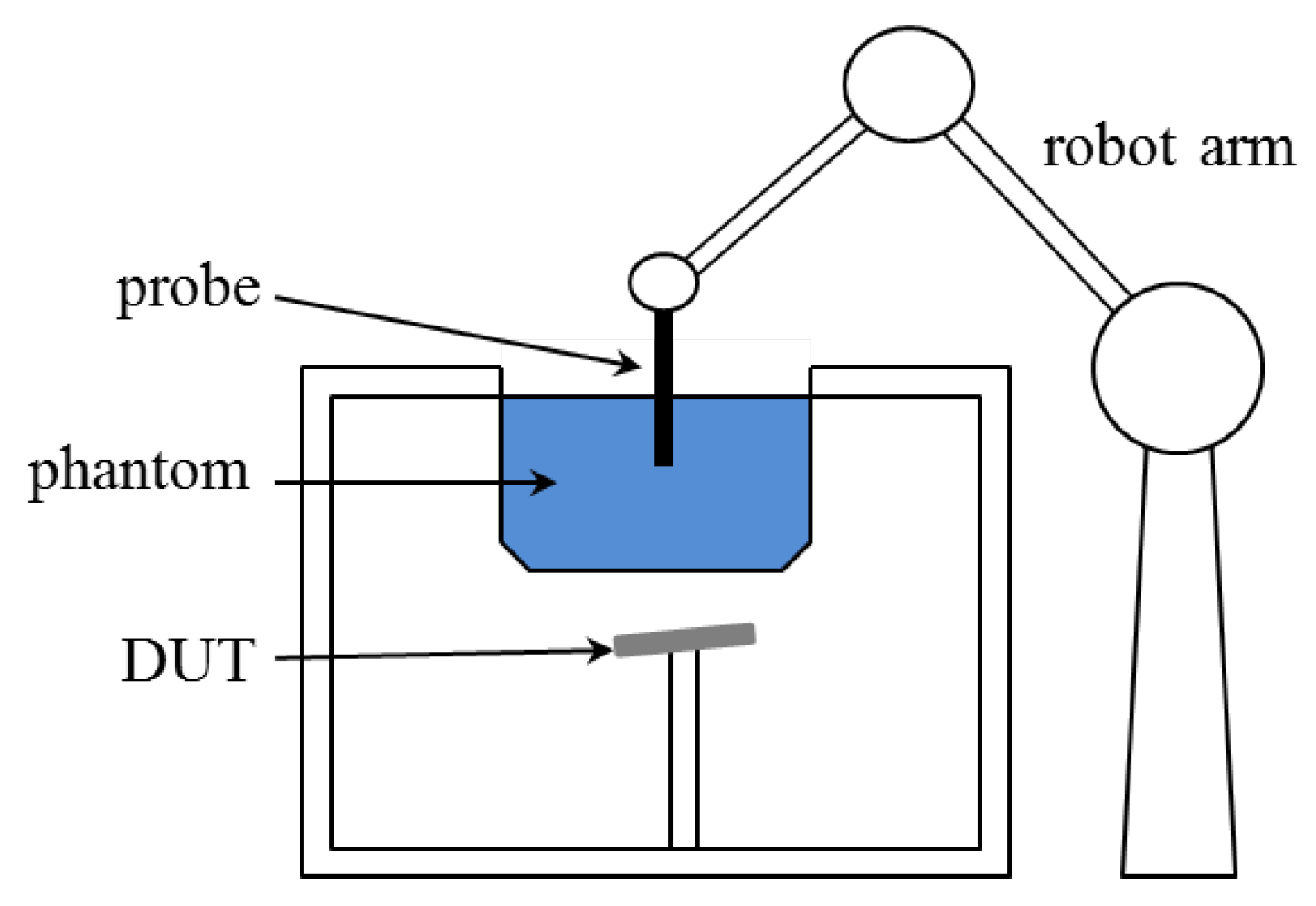
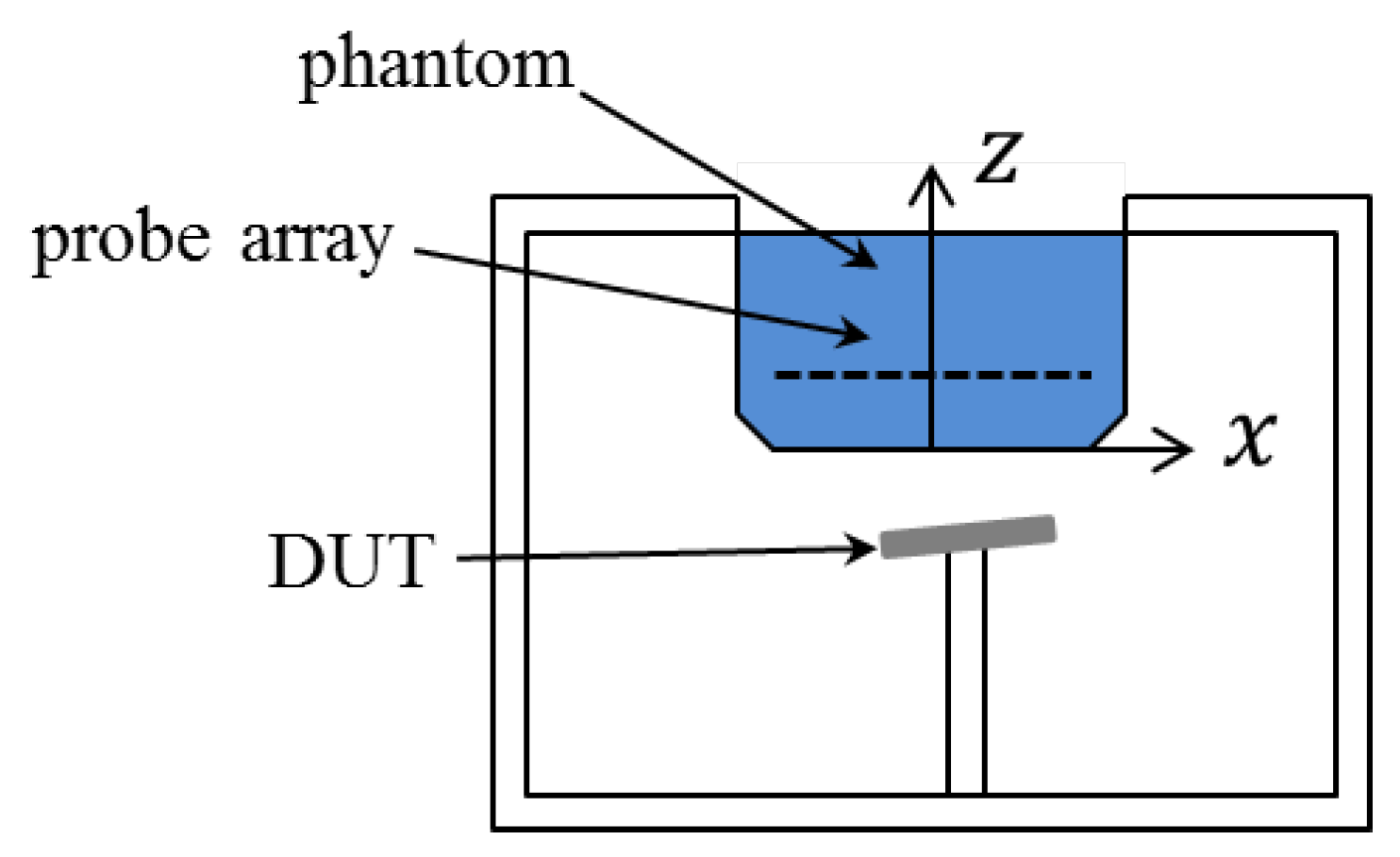

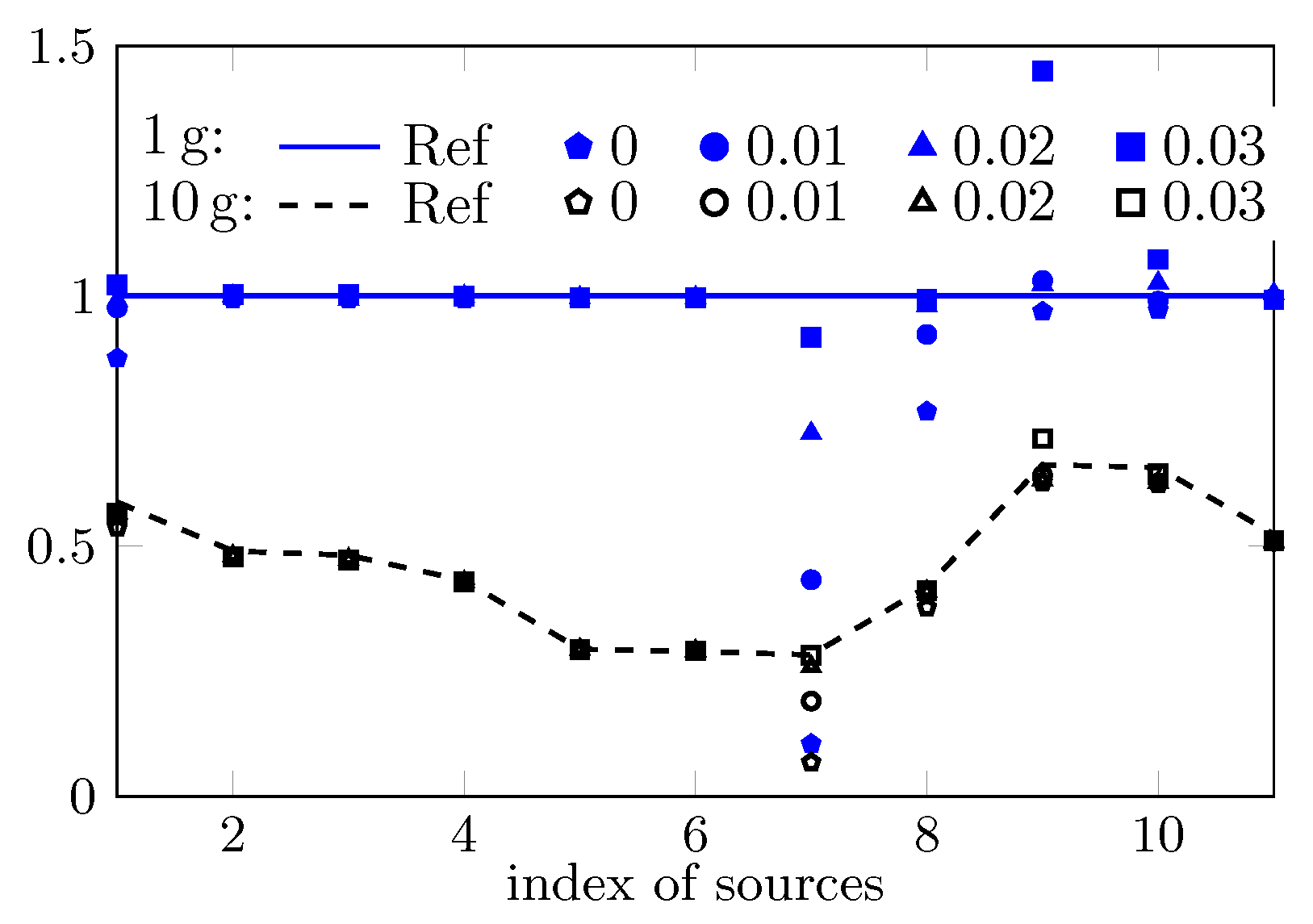

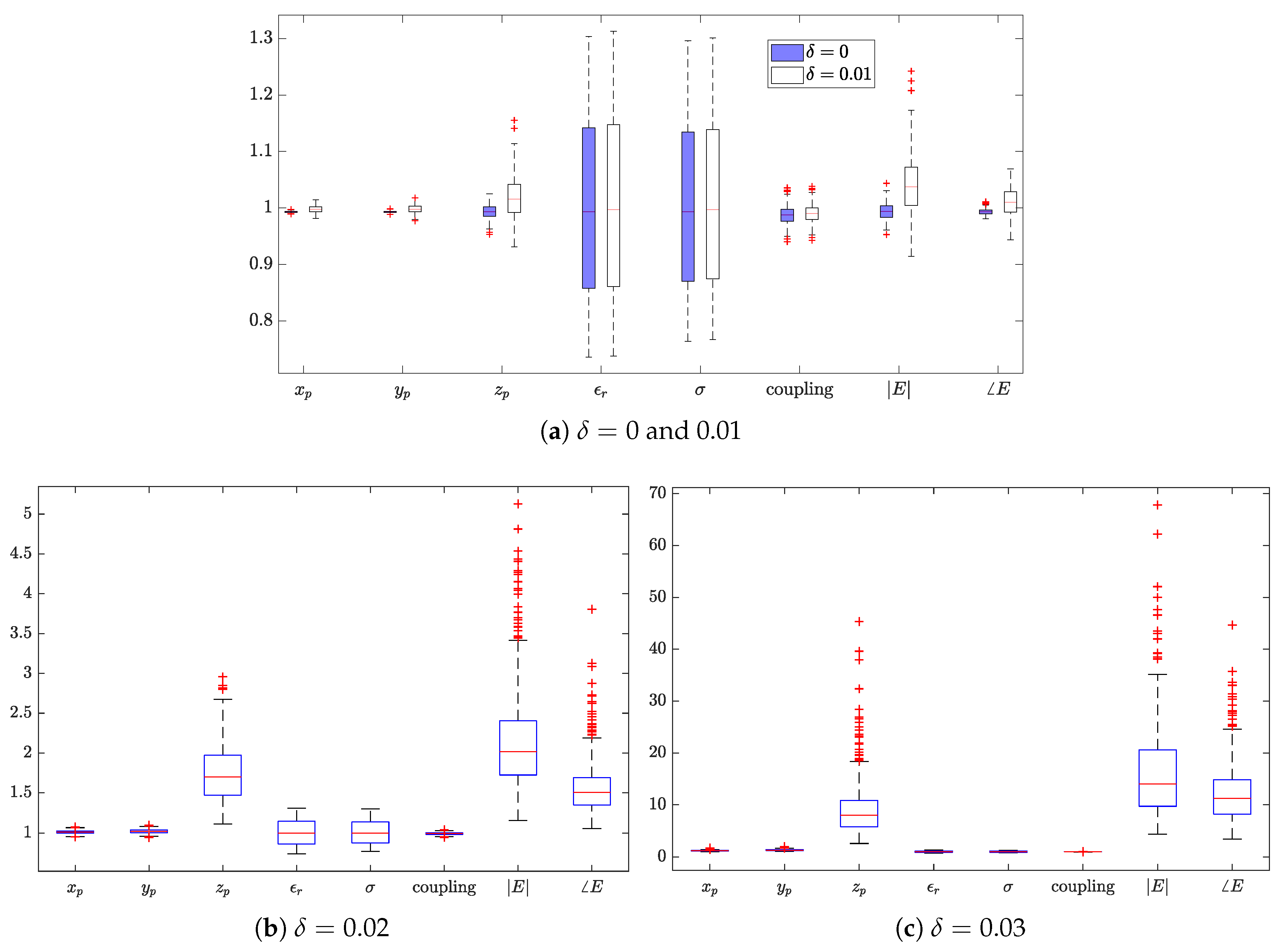
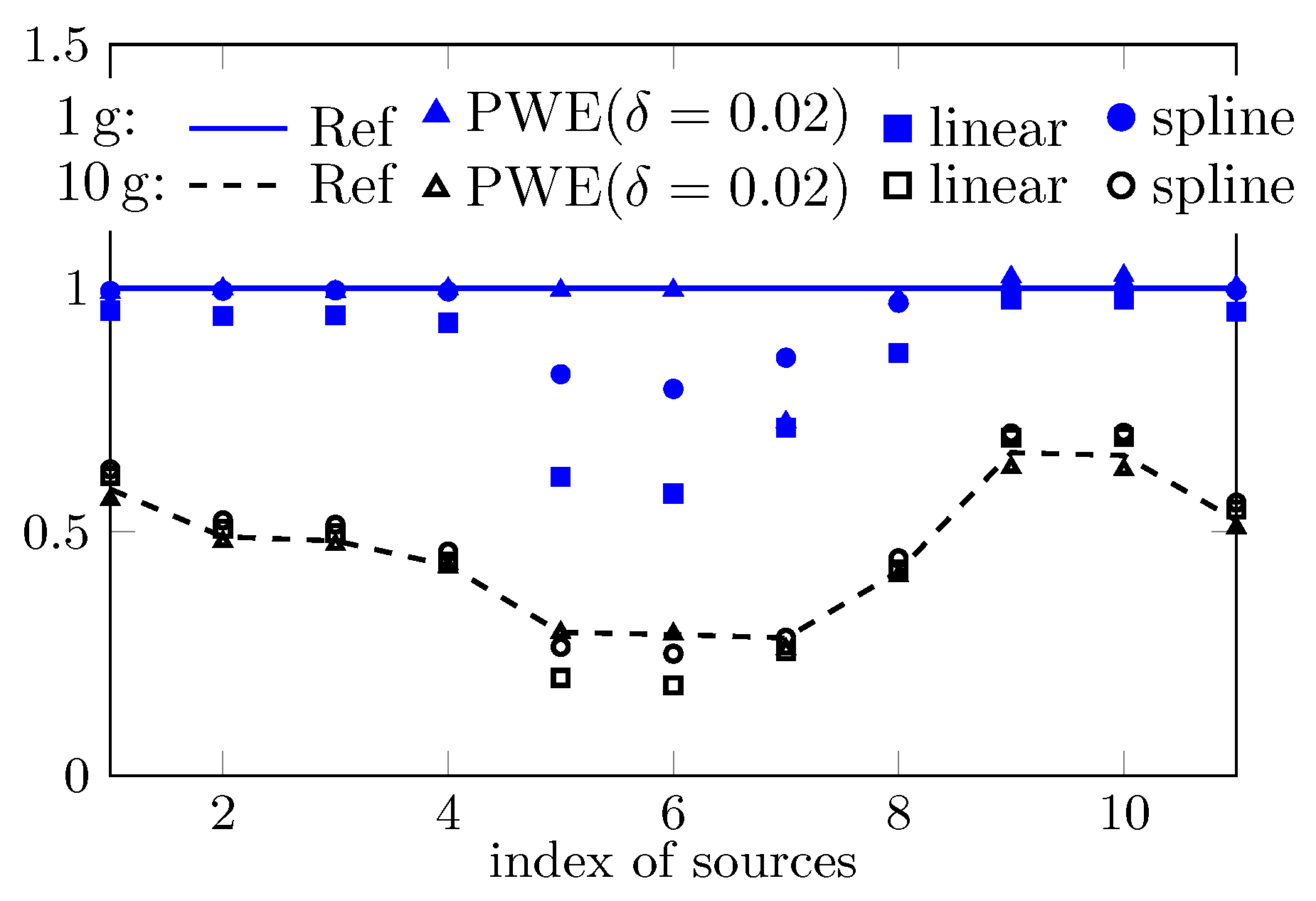
| Area scan | maximum grid spacing | 20 mm if 3 GHz and mm otherwise |
| maximum distance between probe and surface of phantom | 5 mm if 3 GHz and mm otherwise | |
| Zoom scan | horizontal grid spacing | mm |
| minimum scan size | if 3 GHz and otherwise | |
| maximum distance between probe and surface of phantom | 5 mm if 3 Ghz and mm otherwise |
| Index | 1 | 2 | 3 | 4 | 5 | 6 | 7 | 8 | 9 | 10 | 11 |
|---|---|---|---|---|---|---|---|---|---|---|---|
| f (MHz) | 850 | 1800 | 1900 | 2450 | 5500 | 5800 | 750 | 1950 | 750 | 835 | 1750 |
| 42.23 | 40.45 | 40.28 | 39.37 | 33.30 | 32.64 | 42.47 | 40.20 | 42.47 | 42.26 | 40.53 | |
| (S/m) | 0.89 | 1.39 | 1.45 | 1.87 | 5.18 | 5.55 | 0.85 | 1.49 | 0.85 | 0.88 | 1.35 |
| 10g SAR | 0.58 | 0.48 | 0.48 | 0.43 | 0.29 | 0.28 | 0.28 | 0.41 | 0.66 | 0.65 | 0.52 |
| Variable | Description | Distribution |
|---|---|---|
| (mm) | Cartesian coordinates of the probe position | , a being x, y, or z |
| relative permittivity | ||
| (S/m) | conductivity | |
| c (dB) | coupling coefficient | |
| amplitude of electric field | ||
| (radian) | phase angle of electric field |
© 2020 by the authors. Licensee MDPI, Basel, Switzerland. This article is an open access article distributed under the terms and conditions of the Creative Commons Attribution (CC BY) license (http://creativecommons.org/licenses/by/4.0/).
Share and Cite
Liu, Z.; Allal, D.; Cox, M.; Wiart, J. Discrepancies of Measured SAR between Traditional and Fast Measuring Systems. Int. J. Environ. Res. Public Health 2020, 17, 2111. https://0-doi-org.brum.beds.ac.uk/10.3390/ijerph17062111
Liu Z, Allal D, Cox M, Wiart J. Discrepancies of Measured SAR between Traditional and Fast Measuring Systems. International Journal of Environmental Research and Public Health. 2020; 17(6):2111. https://0-doi-org.brum.beds.ac.uk/10.3390/ijerph17062111
Chicago/Turabian StyleLiu, Zicheng, Djamel Allal, Maurice Cox, and Joe Wiart. 2020. "Discrepancies of Measured SAR between Traditional and Fast Measuring Systems" International Journal of Environmental Research and Public Health 17, no. 6: 2111. https://0-doi-org.brum.beds.ac.uk/10.3390/ijerph17062111





